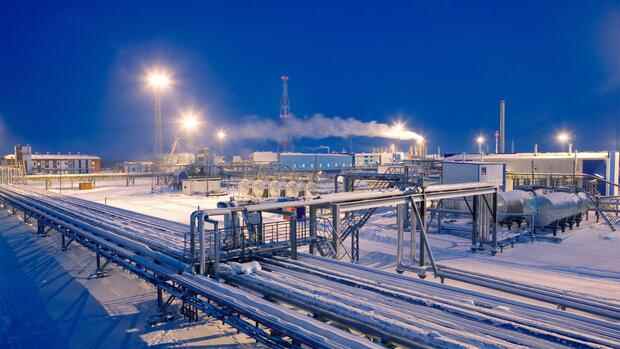Dusseldorf The German gas storage tanks are full just in time for the cold season. Your filling level is more than 95 percent. But will they also get us through the winter? That depends on several factors, it is said again and again. The most obvious: the weather.
Meteorologists are using early long-term models to predict how harsh the winter will be. The later in the year they are released, the more accurate they are. However, first views are possible from October. Various institutes publish forecasts for temperatures, wind speeds – and their implications for energy supply in winter.
The Copernicus Climate Change Services of the European Union provide important orientation. The forecast published on Thursday combines the forecasts of various weather services, including the German Weather Service (DWD). The prospects sound reassuring at first.
Copernicus Climate Change Services Associate Director Samantha Burgess says: “Warm sea conditions and observed trends towards milder winters in Europe suggest that winter overall may be milder than the average in recent years.”
Top jobs of the day
Find the best jobs now and
be notified by email.
However, not only the average temperature is decisive for a secure energy supply in winter. According to Samantha Burgess, the climate institute models indicate a higher chance of calm and dry weather than in a normal year, especially in the first half of winter. That’s not as good for gas consumption as it sounds.
Wind power: Decisive factor for the consumption of gas
The energy and meteorology expert Klaas Dozeman from the analysis company Brainchild Commodity Intelligence says: “A calm first half of winter would greatly promote gas-fired power generation.” A particularly large amount of gas would therefore be burned in power plants to generate electricity – because there is not enough wind power when the weather is calm .
Dozeman says: “On a windless day, Germany only has a wind generation capacity of five gigawatts, while windy days can bring up to 40 gigawatts.” Depending on the weather, wind power can serve more than half of Germany’s electricity consumption – but also almost nothing. So, although people need to heat a little more on windy days, wind can help reduce gas consumption.
Gas storage: Cold winter could completely use up gas storage
A winter, as currently forecast by many weather models, would still be relatively good for the filling levels of German gas storage facilities. This is shown by estimates by energy analysts at US bank JP Morgan.
Assuming that Russian gas continues to flow through Ukraine to Europe, the analysts expect that European gas storage facilities will still be 35 percent full in normal winter weather in March. In a cold winter, they only expect a fill level of 15 percent in March. If the gas supplies via pipelines through Ukraine also dry up, the filling levels could even drop to one percent.
JP Morgan analyst Vincent Ayral says: “We believe that full gas storage and reduced demand should help Europe through the winter. However, a cold winter or other problems on the supply side could lead to mandatory gas cuts in Europe – especially in Germany, which is particularly dependent on Russian gas.”
LNG: Too little supply for the global demand for gas
An important factor for the European gas supply is also the worldwide availability of so-called LNG – liquefied natural gas, which can be transported by ship and is therefore not dependent on pipelines. How much LNG there is to buy and at what price also depends on how much Asia is currently in demand. If it is particularly cold in China, India or Japan, the demand for LNG there also increases.
>> Read also: The Nord Stream 2 Mar: Olaf Scholz campaigned for the pipeline for a long time
However, other factors are currently having a stronger impact on Asian LNG demand. Gas expert Andreas Schröder from the market research company ICIS says: “In the current situation, it helps that China is currently importing 20 percent less LNG than in previous years.” This is due to the lower gas consumption due to Covid lockdowns, but also to the extremely high gas prices.
Looking ahead to the coming months, Schröder says: “Our current global LNG market forecasts indicate that we continue to have a tight market where supply may not be able to meet world demand many months from now.”
High gas prices: Gas shortages exacerbate economic problems
Up until now, Germany has been making sure, with state billions, that as much gas as possible is stored for all winter eventualities. But cold and windless months would not only be a problem for the actual gas stocks – the gas price would also endanger the well-being of the population. And that is also extremely high because of the expensive state purchases of gas.
This is likely to continue in the cold season. Schröder says: “The winter of 2022/2023 will be really expensive again.” This is also shown by an overview of the futures market prices from ICIS: In the months of December to March, the gas price there is consistently more than 170 euros per megawatt hour.
At the peak of the previous price upward spiral at the end of August 2022, the gas price was well over 300 euros. In recent years, however, a megawatt hour of gas only cost between ten and 20 euros.
While the amount of gas consumed depends on the actual weather, gas prices sometimes react to weather forecasts. Even if these later turn out to be wrong, forecasts can drive stock market prices up – cold or not.
More: “Nuclear power? No thanks”: Greens before a difficult party conference.
